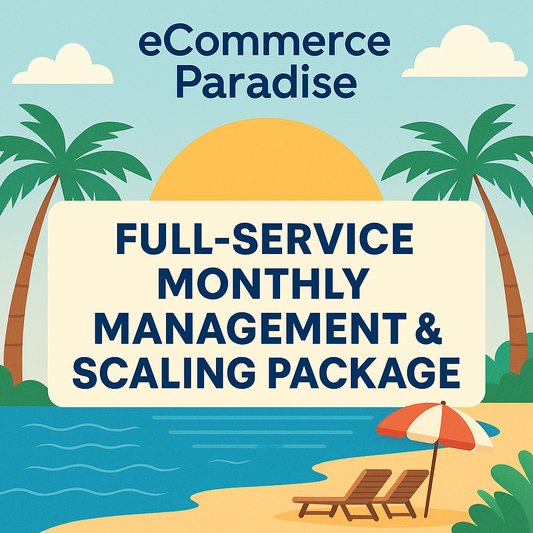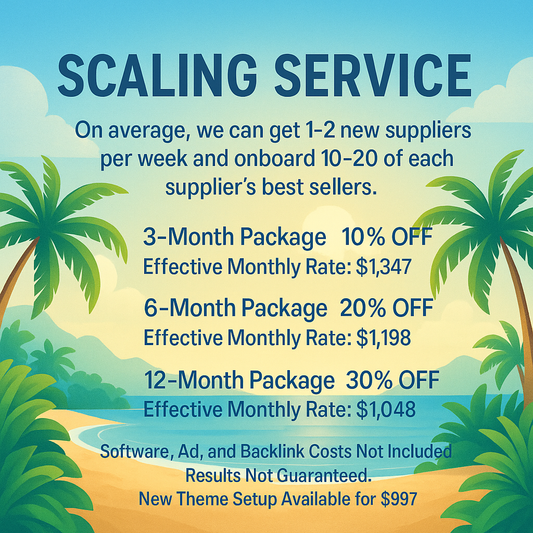
Mastering Pricing Strategies for High-Ticket Products
Welcome to Ecommerce Paradise! If you're diving into the world of high-ticket ecommerce, you're entering an exciting frontier with incredible potential. Selling high-ticket items can drastically elevate your profit margins and boost your dropshipping business to the next level. The right pricing strategy can make all the difference between a modest operation and a thriving online venture. In this article, I’ll guide you through effective pricing strategies that can help you succeed in high-ticket drop shipping.
Understanding High-Ticket Products
Before we delve into pricing strategies, let’s clarify what a high-ticket product is. Typically, high-ticket products are items priced at $1,000 or more. These can range from luxury goods to specialized equipment. The beauty of high-ticket ecommerce lies in the higher profit margins associated with each sale, which allows for a more substantial impact on your bottom line.
Why Sell High-Ticket Products?
- Higher Profit Margins: Selling fewer items at a higher price can lead to greater profits without needing to increase your workload significantly.
- Targeted Range of Customers: High-ticket products often attract customers who are willing to invest in quality and exclusivity.
- Reduced Volume of Sales Needed: You can achieve substantial revenue with fewer transactions, making your business more manageable.
But with great opportunity comes the need for effective pricing strategies. Let’s break down key tactics to maximize your success.
The Psychology of Pricing
The first step in your pricing strategy is understanding the psychology behind pricing. How you present your products can influence how customers perceive their value.
The Anchor Pricing Strategy
An effective approach in high-ticket sales is the anchor pricing strategy. This involves displaying a higher original price alongside the new discounted price. This tactic creates a psychological anchor point in the customer’s mind, making the new price seem like a fantastic deal.
When customers see that they are getting a good deal, they are more inclined to click the buy button. It’s crucial to ensure the original price feels credible, so don’t inflate it too much—consumers are savvy and can often recognize when a price is exaggerated.
Competitive Analysis
Competitor pricing analysis is vital in the ecommerce landscape, especially when dealing with high-ticket items. Research can help you understand where your prices should stand within the market. Look at how your competitors price similar products and find a niche that offers you a competitive edge.
Assessing Market Trends
Staying aware of market trends can also influence your pricing strategy. Are your competitors experiencing successful sales at a particular price point? Make note of seasonal trends, and temporarily adjust pricing as necessary to capitalize on high-demand periods.
Value-Based Pricing
Another effective strategy for high-ticket ecommerce is value-based pricing. This pricing strategy focuses on the perceived value of your product to the customer rather than solely on the cost of production. Understand what customers are willing to pay by researching their perceptions, preferences, and needs.
Adding Value
To successfully implement this strategy, you may need to enhance your offering. Consider adding services or benefits that augment the perceived value of your products:
- Exceptional Customer Service: Offering superb customer support can swaddle your high-ticket items in a layer of trust.
- Free Shipping: Implementing free shipping for high-ticket items can make the purchase feel worthwhile.
- Warranties and Guarantees: Providing added peace of mind through warranties can justify a higher price point.
Bundle Pricing
Another tactic to consider in high-ticket drop shipping is bundling. By packaging complementary items together, you can create an inviting offer that encourages customers to spend more while feeling like they are receiving a deal.
Creating Bundles that Make Sense
When creating bundles, ensure that the items work well together. For instance, if you’re selling a high-end camera, consider bundling it with accessories such as lenses or a durable carrying case. This not only increases the average order value but also enhances customer satisfaction as they receive a complete solution.
Licensing and Exclusivity
For high-ticket products, exclusivity can wield considerable influence over pricing. Imagine the perceived value of a limited edition or exclusive product. Using licensing or offering exclusive rights for certain products can empower you to set higher prices.
Create Scarcity
Implement tactics that create a sense of scarcity. Limited-time offers or exclusive collections can incite urgency among potential buyers. When customers believe that an item may not be available forever, they’re more likely to make a purchase.
Implementing Subscription Models
While many high-ticket items are typically sold in one-time transactions, introducing a subscription model can create a recurrent stream of revenue. For example, consider offering payment plans or subscription bundles for high-ticket items. By breaking down the total cost into manageable installments, you can widen your customer base.
Promote Payment Flexibility
Making it convenient for customers to purchase high-ticket items is essential. Emphasize the flexibility you offer with payment plans, potentially even connecting with third-party financing companies to facilitate smooth transactions. When customers know they can afford the product, they are more likely to follow through with a purchase.
Tracking and Analyzing Your Results
Once you’ve begun implementing a pricing strategy, it’s vital to track your results. Utilizing tools such as Google Analytics and Shopify’s built-in reports will help you assess whether your current approach is effective or if it needs fine-tuning.
Key Performance Indicators (KPIs)
Focus on tracking specific KPIs that are relevant to your high-ticket pricing strategies:
- Conversion Rates: Are more customers completing purchases at your price points?
- Average Order Value: Are bundles or upsells increasing the average spend?
- Customer Satisfaction and Retention: Are you receiving positive customer feedback or repeat business?
Final Thoughts: Your High-Ticket eCommerce Journey Awaits!
By mastering these pricing strategies, you can effectively position your high-ticket products for success in the dropshipping arena. Remember that the landscape is ever-changing, so stay flexible and responsive to both market trends and customer needs. With diligence and thoughtful strategizing, your high-ticket ecommerce business can reach extraordinary heights. Your journey is just beginning, and the potential is limitless.


















